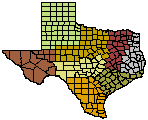-
MLDP:
- Managed Lands Deer Program
- Trans Pecos
- High Plains/Panhandle
- Cross Timbers
- Hill Country
- Post Oak Savannah
- Pineywoods
- Oak Prairie
- South Texas Plains

Wildlife Division District Map
Pineywoods Wildlife Management
White-tailed Deer Management
The whitetail deer is unquestionably the highest profile game animal in the Pineywoods of east Texas. Populations are monitored through a series of different surveys to evaluate the approximate density, the general health of the herd, and the impact of the deer herd on the habitat. This information is collected through a series of surveys including spotlight lines, age/weight/antler data collection on harvested deer, and browse surveys. Of these, only the age/weight/antler data gives a snapshot in time of the condition of the herd. The others provide information which is useful in tracking the trends of the herd and evaluating the direction of our management decisions.
Spotlight line information is collected throughout the Pineywoods during the months of July and August. Spotlight lines were established in the early 1980’s and have been run on the same route annually since. These lines are 15 miles long and theoretically cover all the different habitat types in the area. The total number of deer are counted and recorded as number of bucks, does, fawns, and unknown. Additionally, distance that the observer would likely be able to see a deer perpendicular from the truck is recorded every 1/10 of a mile. This information is then used to determine the acreage observed on the 15 mile route. The number of deer observed and the acreage is then run through a math formula which gives the approximate deer density in the area.
Annual age/weight/antler data is collected from harvested deer throughout the Pineywoods at hunting clubs, processing plants, cold storage facilities and Wildlife Management Area check stations. The data collected includes the age of the deer, the field dressed body weight, antler dimensions on bucks, and if the doe is lactating (milk in the udder). This information is used to determine the overall health of the deer herd. If these measurements are up, it will mean that the habitat conditions have been good, the deer are at or below carrying capacity, and that overall health conditions are good for the deer herd in general. Conversely, if these measurements are down, it indicates some type of problem with the health of the herd.
Browse surveys are a measure of the amount of browse (food) the deer have consumed. These surveys can be conducted at different times of the year; however they are the most useful when conducted during the latter part of January and February prior to spring green-up. Surveys are conducted to determine if they are eating very little of the available forage, moderate amounts, or excessive amounts of the plants available. This information can then be used to determine where the deer herd is related to carrying capacity. Carrying capacity is determined by how many animals the habitat can carry without detriment to the animals or the habitat they are using. This information in conjunction with the age/weight/antler information then gives the biologist information on which to base harvest and management goals.
The data collected through these survey efforts are then put together like pieces of a large puzzle. The trends from year to year are analyzed to determine if the management direction is appropriate with regards to the direction the health and population of the deer herd is headed. Large scale adjustments are done through the use of county wide regulations determining the bag limits within a group of counties. Adjustments can also be made on a smaller scale allowing the individual landowner or manager to achieve specific management objectives.
 (
(